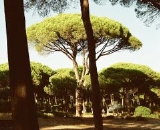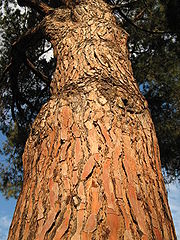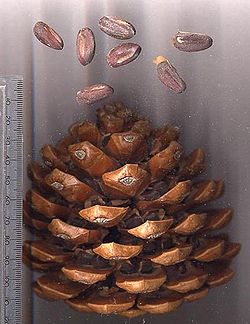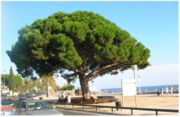
Stone Pine
Encyclopedia
The Stone Pine is also called Italian Stone Pine, or Umbrella Pine (not to be confused with the Japanese Umbrella pine (Sciadopitys verticillata)
), and Parasol Pine. It is in the pine
family Pinaceae
and occasionally listed under the invalid name Pinus sativa. The tree is native to the Mediterranean region. It occurs in Southern Europe
, North Africa
, and the Levant
.
Stone pines have been used and cultivated for their edible pine nut
s since prehistoric times. They are widespread in horticultural cultivation as ornamental trees, planted in gardens and parks around the world.
regions during a more humid climate period, in present day Morocco, Algeria, Tunisia, and Libya. Its contemporary natural range is in the Mediterranean forests, woodlands, and scrub
biome
ecoregion
s and countries, including:
Southern Europe:
The Iberian conifer forests
ecoregion of the Iberian Peninsula
in Spain and Portugal; the Italian sclerophyllous and semideciduous forests
ecoregion in France and Italy; the Tyrrhenian-Adriatic sclerophyllous and mixed forests
ecoregion of southern Italy, Sicily
, and Sardinia
; the Illyrian deciduous forests
of the eastern coast of the Ionian
and Adriatic Sea
s in Croatia and Albania
; and the Aegean and Western Turkey sclerophyllous and mixed forests ecoregion of the southern Balkan Peninsula
in Greece
In Greece, although rare, an extensive Stone Pine forest exists in western Peloponnese
at Strofylia on the peninsula separating the Kalogria Lagoon from the Mediterranean Sea
. This coastal forest is at least 8 miles long, with dense and tall stands of Pinus pinea mixed with Pinus halepensis. Currently, Pinus halepensis is outcompeting Stone Pines in many locations of the forest. Another location in Greece, is at Koukounaries
on the northern Aegean island of Skiathos
at the southwest corner of the island. This is a half a mile long dense stand of Stone and Aleppo Pines that lies between a lagoon and the Aegean Sea
. A fine-textured sand beach lies between the Koukounaries
forest and the sea.
Western Asia:
In Western Asia, the Eastern Mediterranean conifer-sclerophyllous-broadleaf forests
ecoregion in Turkey; and the Southern Anatolian montane conifer and deciduous forests ecoregion in Lebanon, Syria, and northern Israel
northern Africa
The Mediterranean woodlands and forests
ecoregion of North Africa
, in Morocco and Algeria

 Pinus pinea, the Stone Pine grows to 12–20 m (39.4–65.6 ft) in height, and can exceed 25 metres (82 ft) height. In youth, it is a bushy globe, in mid-age an umbrella canopy on a thick trunk, and, in maturity, a broad and flat crown 40–60 m (131.2–196.9 ft) in width. The bark
Pinus pinea, the Stone Pine grows to 12–20 m (39.4–65.6 ft) in height, and can exceed 25 metres (82 ft) height. In youth, it is a bushy globe, in mid-age an umbrella canopy on a thick trunk, and, in maturity, a broad and flat crown 40–60 m (131.2–196.9 ft) in width. The bark
is thick, red-brown and deeply fissured into broad vertical plates.
Foliage
The flexible mid-green leaves are needle-like, in bundles of two, and are 10–20 cm (3.9–7.9 in) long (exceptionally up to 30 centimetres (11.8 in)). Young trees up to 5–10 years old bear juvenile leaves, which are very different, single (not paired), 2–4 cm (0.78740157480315–1.6 in) long, glaucous blue-green; the adult leaves appear mixed with juvenile leaves from the fourth or fifth year on, replacing it fully by around the tenth year. Juvenile leaves are also produced in regrowth following injury, such as a broken shoot, on older trees.
Cones
The cones are broad, ovoid, 8–15 cm (3.1–5.9 in) long, and take 36 months to mature, longer than any other pine. The seeds (pine nut
s, piñones, pinhões, pinoli, or pignons) are large, 2 centimetre (0.78740157480315 in) long, and pale brown with a powdery black coating that rubs off easily, and have a rudimentary 4–8 mm (0.15748031496063–0.31496062992126 in) wing that falls off very easily. The wing is ineffective for wind dispersal, and the seeds are animal-dispersed, originally mainly by the azure-winged magpie
, but in recent history, very largely by human
s.
period. In the 1700s, Pinus pinea began being introduced as an ornamental tree to other Mediterranean climate
regions of the world, and is now often found in gardens and parks in South Africa, California
, and Australia. It has naturalized beyond cities in South Africa to the extent that it is listed as an invasive species
there. It is also planted in western Europe
up to southern Scotland, and on the East Coast of the United States
up to New Jersey
.
Small specimens are used for Bonsai
, and also grown in large pots and planters. The year-old seedlings are seasonally available as 20–30 cm (7.9–11.8 in) tall table-top Christmas tree
s.
 .
.
was accidentally imported with timber to northern Italy in the late 1990s, and has spread across Europe as an invasive pest species since then. It feeds on the sap of developing conifer cones throughout its life, and its sap-sucking causes the developing seeds to wither and misdevelop. It has destroyed most of the pine nut seeds in Italy, threatening Pinus pinea in its native
habitat
s there.
Sciadopitys
The Koyamaki , or Japanese Umbrella-pine, is a unique conifer endemic to Japan. It is the sole member of the family Sciadopityaceae and genus Sciadopitys, a living fossil with no close relatives, and known in the fossil record for about 230 million years.Its genus name comes from the Greek prefix...
), and Parasol Pine. It is in the pine
Pine
Pines are trees in the genus Pinus ,in the family Pinaceae. They make up the monotypic subfamily Pinoideae. There are about 115 species of pine, although different authorities accept between 105 and 125 species.-Etymology:...
family Pinaceae
Pinaceae
Pinaceae are trees or shrubs, including many of the well-known conifers of commercial importance such as cedars, firs, hemlocks, larches, pines and spruces. The family is included in the order Pinales, formerly known as Coniferales. Pinaceae are supported as monophyletic by its protein-type sieve...
and occasionally listed under the invalid name Pinus sativa. The tree is native to the Mediterranean region. It occurs in Southern Europe
Southern Europe
The term Southern Europe, at its most general definition, is used to mean "all countries in the south of Europe". However, the concept, at different times, has had different meanings, providing additional political, linguistic and cultural context to the definition in addition to the typical...
, North Africa
North Africa
North Africa or Northern Africa is the northernmost region of the African continent, linked by the Sahara to Sub-Saharan Africa. Geopolitically, the United Nations definition of Northern Africa includes eight countries or territories; Algeria, Egypt, Libya, Morocco, South Sudan, Sudan, Tunisia, and...
, and the Levant
Levant
The Levant or ) is the geographic region and culture zone of the "eastern Mediterranean littoral between Anatolia and Egypt" . The Levant includes most of modern Lebanon, Syria, Jordan, Israel, the Palestinian territories, and sometimes parts of Turkey and Iraq, and corresponds roughly to the...
.
Stone pines have been used and cultivated for their edible pine nut
Pine nut
Pine nuts are the edible seeds of pines . About 20 species of pine produce seeds large enough to be worth harvesting; in other pines the seeds are also edible, but are too small to be of great value as a human food....
s since prehistoric times. They are widespread in horticultural cultivation as ornamental trees, planted in gardens and parks around the world.
Distribution
The prehistoric range of Pinus pinea included North Africa in the Sahara Desert and MaghrebMaghreb
The Maghreb is the region of Northwest Africa, west of Egypt. It includes five countries: Morocco, Algeria, Tunisia, Libya, and Mauritania and the disputed territory of Western Sahara...
regions during a more humid climate period, in present day Morocco, Algeria, Tunisia, and Libya. Its contemporary natural range is in the Mediterranean forests, woodlands, and scrub
Mediterranean forests, woodlands, and scrub
Mediterranean forests, woodlands, and scrub biome, defined by the World Wildlife Fund, characterized by dry summers and rainy winters. Summers are typically hot in low-lying inland locations but can be cool near some seas, as near San Francisco, which have a sea of cool waters...
biome
Biome
Biomes are climatically and geographically defined as similar climatic conditions on the Earth, such as communities of plants, animals, and soil organisms, and are often referred to as ecosystems. Some parts of the earth have more or less the same kind of abiotic and biotic factors spread over a...
ecoregion
Ecoregion
An ecoregion , sometimes called a bioregion, is an ecologically and geographically defined area that is smaller than an ecozone and larger than an ecosystem. Ecoregions cover relatively large areas of land or water, and contain characteristic, geographically distinct assemblages of natural...
s and countries, including:
Southern Europe:
The Iberian conifer forests
Forests of the Iberian Peninsula
The woodlands of the Iberian Peninsula are distinct ecosystems on the Iberian Peninsula, spanning mainly Spain and Portugal. Although the various regions are each characterized by distinct vegetation, there are some similarities across the peninsula....
ecoregion of the Iberian Peninsula
Iberian Peninsula
The Iberian Peninsula , sometimes called Iberia, is located in the extreme southwest of Europe and includes the modern-day sovereign states of Spain, Portugal and Andorra, as well as the British Overseas Territory of Gibraltar...
in Spain and Portugal; the Italian sclerophyllous and semideciduous forests
Italian sclerophyllous and semi-deciduous forests
The term Italian Sclerophyllous and deciduous forests ecoregion, in the Mediterranean forests, woodlands, and scrub Biome, is in Italy. The region extends from the Po Basin to the Apennine Mountains of Basilicata and Calabria...
ecoregion in France and Italy; the Tyrrhenian-Adriatic sclerophyllous and mixed forests
Tyrrhenian-Adriatic sclerophyllous and mixed forests
The Thyrrenian-Adriatic Sclerophyllous and Mixed Forests Ecoregion, in the Mediterranean forests, woodlands, and scrub Biome, is in southern Italy, Sicily, Corsica, and the Dalmatian Islands.-Major forest zones:...
ecoregion of southern Italy, Sicily
Sicily
Sicily is a region of Italy, and is the largest island in the Mediterranean Sea. Along with the surrounding minor islands, it constitutes an autonomous region of Italy, the Regione Autonoma Siciliana Sicily has a rich and unique culture, especially with regard to the arts, music, literature,...
, and Sardinia
Sardinia
Sardinia is the second-largest island in the Mediterranean Sea . It is an autonomous region of Italy, and the nearest land masses are the French island of Corsica, the Italian Peninsula, Sicily, Tunisia and the Spanish Balearic Islands.The name Sardinia is from the pre-Roman noun *sard[],...
; the Illyrian deciduous forests
Illyrian deciduous forests
The Illyrian deciduous forests form a terrestrial ecoregion of Europe according to both the WWF and Digital Map of European Ecological Regions by the European Environment Agency...
of the eastern coast of the Ionian
Ionian Sea
The Ionian Sea , is an arm of the Mediterranean Sea, south of the Adriatic Sea. It is bounded by southern Italy including Calabria, Sicily and the Salento peninsula to the west, southern Albania to the north, and a large number of Greek islands, including Corfu, Zante, Kephalonia, Ithaka, and...
and Adriatic Sea
Adriatic Sea
The Adriatic Sea is a body of water separating the Italian Peninsula from the Balkan peninsula, and the system of the Apennine Mountains from that of the Dinaric Alps and adjacent ranges...
s in Croatia and Albania
Albania
Albania , officially known as the Republic of Albania , is a country in Southeastern Europe, in the Balkans region. It is bordered by Montenegro to the northwest, Kosovo to the northeast, the Republic of Macedonia to the east and Greece to the south and southeast. It has a coast on the Adriatic Sea...
; and the Aegean and Western Turkey sclerophyllous and mixed forests ecoregion of the southern Balkan Peninsula
Balkans
The Balkans is a geopolitical and cultural region of southeastern Europe...
in Greece
In Greece, although rare, an extensive Stone Pine forest exists in western Peloponnese
Peloponnese
The Peloponnese, Peloponnesos or Peloponnesus , is a large peninsula , located in a region of southern Greece, forming the part of the country south of the Gulf of Corinth...
at Strofylia on the peninsula separating the Kalogria Lagoon from the Mediterranean Sea
Mediterranean Sea
The Mediterranean Sea is a sea connected to the Atlantic Ocean surrounded by the Mediterranean region and almost completely enclosed by land: on the north by Anatolia and Europe, on the south by North Africa, and on the east by the Levant...
. This coastal forest is at least 8 miles long, with dense and tall stands of Pinus pinea mixed with Pinus halepensis. Currently, Pinus halepensis is outcompeting Stone Pines in many locations of the forest. Another location in Greece, is at Koukounaries
Koukounaries
Koukounaries is a location and a beach in the southwest part of the island of Skiathos in Greece. It is 16 km southwest of the main town on the island. Skiathos is part of the Sporades group of islands in the Northern Aegean Sea....
on the northern Aegean island of Skiathos
Skiathos
Skiathos is a small Greek island in the northwest Aegean Sea. Skiathos is the westernmost island in the Northern Sporades group, east of the Pelion peninsula in Magnesia on the mainland, and west of the island of Skopelos.-Geography:...
at the southwest corner of the island. This is a half a mile long dense stand of Stone and Aleppo Pines that lies between a lagoon and the Aegean Sea
Aegean Sea
The Aegean Sea[p] is an elongated embayment of the Mediterranean Sea located between the southern Balkan and Anatolian peninsulas, i.e., between the mainlands of Greece and Turkey. In the north, it is connected to the Marmara Sea and Black Sea by the Dardanelles and Bosporus...
. A fine-textured sand beach lies between the Koukounaries
Koukounaries
Koukounaries is a location and a beach in the southwest part of the island of Skiathos in Greece. It is 16 km southwest of the main town on the island. Skiathos is part of the Sporades group of islands in the Northern Aegean Sea....
forest and the sea.
Western Asia:
In Western Asia, the Eastern Mediterranean conifer-sclerophyllous-broadleaf forests
Eastern Mediterranean conifer-sclerophyllous-broadleaf forests
The Eastern Mediterranean conifer-sclerophyllous-broadleaf forests ecoregion, in the Mediterranean forests, woodlands, and scrub biome, is of the eastern Mediterranean Basin.-Setting:...
ecoregion in Turkey; and the Southern Anatolian montane conifer and deciduous forests ecoregion in Lebanon, Syria, and northern Israel
northern Africa
The Mediterranean woodlands and forests
Mediterranean woodlands and forests
The Mediterranean woodlands and forests is an ecoregion, of the Mediterranean forests, woodlands, and scrub Biome, in the coastal plains, hills, and mountains bordering the Mediterranean Sea and Atlantic Ocean in North Africa.-Geography:...
ecoregion of North Africa
North Africa
North Africa or Northern Africa is the northernmost region of the African continent, linked by the Sahara to Sub-Saharan Africa. Geopolitically, the United Nations definition of Northern Africa includes eight countries or territories; Algeria, Egypt, Libya, Morocco, South Sudan, Sudan, Tunisia, and...
, in Morocco and Algeria
Description


Bark
Bark is the outermost layers of stems and roots of woody plants. Plants with bark include trees, woody vines and shrubs. Bark refers to all the tissues outside of the vascular cambium and is a nontechnical term. It overlays the wood and consists of the inner bark and the outer bark. The inner...
is thick, red-brown and deeply fissured into broad vertical plates.
Foliage
The flexible mid-green leaves are needle-like, in bundles of two, and are 10–20 cm (3.9–7.9 in) long (exceptionally up to 30 centimetres (11.8 in)). Young trees up to 5–10 years old bear juvenile leaves, which are very different, single (not paired), 2–4 cm (0.78740157480315–1.6 in) long, glaucous blue-green; the adult leaves appear mixed with juvenile leaves from the fourth or fifth year on, replacing it fully by around the tenth year. Juvenile leaves are also produced in regrowth following injury, such as a broken shoot, on older trees.
Cones
The cones are broad, ovoid, 8–15 cm (3.1–5.9 in) long, and take 36 months to mature, longer than any other pine. The seeds (pine nut
Pine nut
Pine nuts are the edible seeds of pines . About 20 species of pine produce seeds large enough to be worth harvesting; in other pines the seeds are also edible, but are too small to be of great value as a human food....
s, piñones, pinhões, pinoli, or pignons) are large, 2 centimetre (0.78740157480315 in) long, and pale brown with a powdery black coating that rubs off easily, and have a rudimentary 4–8 mm (0.15748031496063–0.31496062992126 in) wing that falls off very easily. The wing is ineffective for wind dispersal, and the seeds are animal-dispersed, originally mainly by the azure-winged magpie
Azure-winged Magpie
The Azure-winged Magpie is a bird in the crow family. It is 31–35 cm long and similar in overall shape to the European Magpie but is more slender with proportionately smaller legs and bill. It belongs to the monotypical genus Cyanopica.It has a glossy black top to the head and a white throat...
, but in recent history, very largely by human
Human
Humans are the only living species in the Homo genus...
s.
Food
Pinus pinea has been cultivated extensively for at least 6,000 years for the edible pine nuts. These have been trade items since early historic times. It has been cultivated throughout the Mediterranean region for so long that it has naturalized, and is often considered native beyond its natural range.Ornamental tree
In Italy, the Stone Pine has been an aesthetic landscape element since the Italian Renaissance gardenItalian Renaissance garden
The Italian Renaissance garden was a new style of garden which emerged in the late 15th century at villas in Rome and Florence, inspired by classical ideals of order and beauty, and intended for the pleasure of the view of the garden and the landscape beyond, for contemplation, and for the...
period. In the 1700s, Pinus pinea began being introduced as an ornamental tree to other Mediterranean climate
Mediterranean climate
A Mediterranean climate is the climate typical of most of the lands in the Mediterranean Basin, and is a particular variety of subtropical climate...
regions of the world, and is now often found in gardens and parks in South Africa, California
California
California is a state located on the West Coast of the United States. It is by far the most populous U.S. state, and the third-largest by land area...
, and Australia. It has naturalized beyond cities in South Africa to the extent that it is listed as an invasive species
Invasive species
"Invasive species", or invasive exotics, is a nomenclature term and categorization phrase used for flora and fauna, and for specific restoration-preservation processes in native habitats, with several definitions....
there. It is also planted in western Europe
Western Europe
Western Europe is a loose term for the collection of countries in the western most region of the European continents, though this definition is context-dependent and carries cultural and political connotations. One definition describes Western Europe as a geographic entity—the region lying in the...
up to southern Scotland, and on the East Coast of the United States
East Coast of the United States
The East Coast of the United States, also known as the Eastern Seaboard, refers to the easternmost coastal states in the United States, which touch the Atlantic Ocean and stretch up to Canada. The term includes the U.S...
up to New Jersey
New Jersey
New Jersey is a state in the Northeastern and Middle Atlantic regions of the United States. , its population was 8,791,894. It is bordered on the north and east by the state of New York, on the southeast and south by the Atlantic Ocean, on the west by Pennsylvania and on the southwest by Delaware...
.
Small specimens are used for Bonsai
Bonsai
is a Japanese art form using miniature trees grown in containers. Similar practices exist in other cultures, including the Chinese tradition of penjing from which the art originated, and the miniature living landscapes of Vietnamese hòn non bộ...
, and also grown in large pots and planters. The year-old seedlings are seasonally available as 20–30 cm (7.9–11.8 in) tall table-top Christmas tree
Christmas tree
The Christmas tree is a decorated evergreen coniferous tree, real or artificial, and a tradition associated with the celebration of Christmas. The tradition of decorating an evergreen tree at Christmas started in Livonia and Germany in the 16th century...
s.

Pests
The introduced western conifer seed bug (Leptoglossus occidentalis)Western conifer seed bug
The western conifer seed bug, Leptoglossus occidentalis, sometimes abbreviated as WCSB, is a species of true bug in the family Coreidae...
was accidentally imported with timber to northern Italy in the late 1990s, and has spread across Europe as an invasive pest species since then. It feeds on the sap of developing conifer cones throughout its life, and its sap-sucking causes the developing seeds to wither and misdevelop. It has destroyed most of the pine nut seeds in Italy, threatening Pinus pinea in its native
Native plant
Native plant is a term to describe plants endemic or naturalized to a given area in geologic time.This includes plants that have developed, occur naturally, or existed for many years in an area...
habitat
Habitat
* Habitat , a place where a species lives and grows*Human habitat, a place where humans live, work or play** Space habitat, a space station intended as a permanent settlement...
s there.
See also
- Mediterranean forests, woodlands, and scrubMediterranean forests, woodlands, and scrubMediterranean forests, woodlands, and scrub biome, defined by the World Wildlife Fund, characterized by dry summers and rainy winters. Summers are typically hot in low-lying inland locations but can be cool near some seas, as near San Francisco, which have a sea of cool waters...
— BiomeBiomeBiomes are climatically and geographically defined as similar climatic conditions on the Earth, such as communities of plants, animals, and soil organisms, and are often referred to as ecosystems. Some parts of the earth have more or less the same kind of abiotic and biotic factors spread over a... - Index: Flora of the Mediterranean

